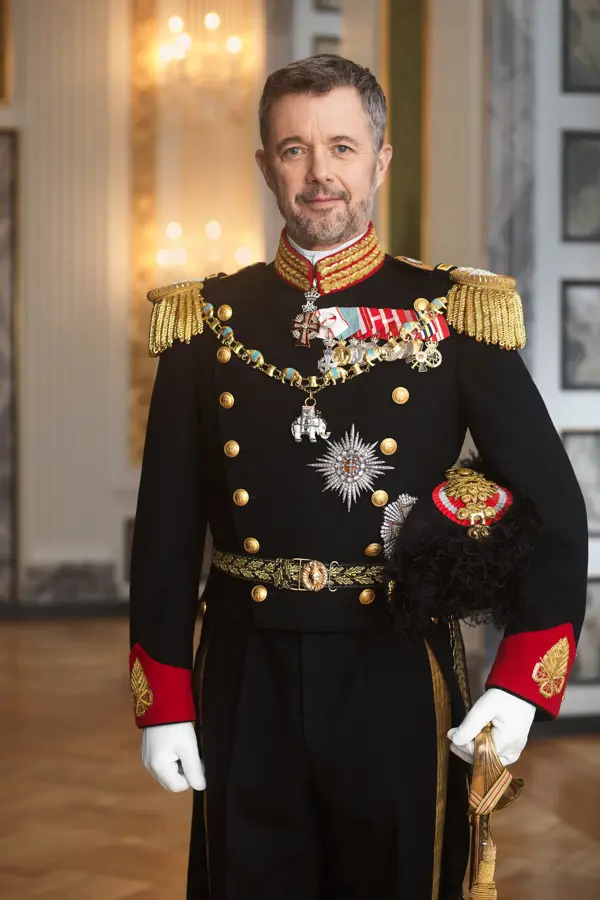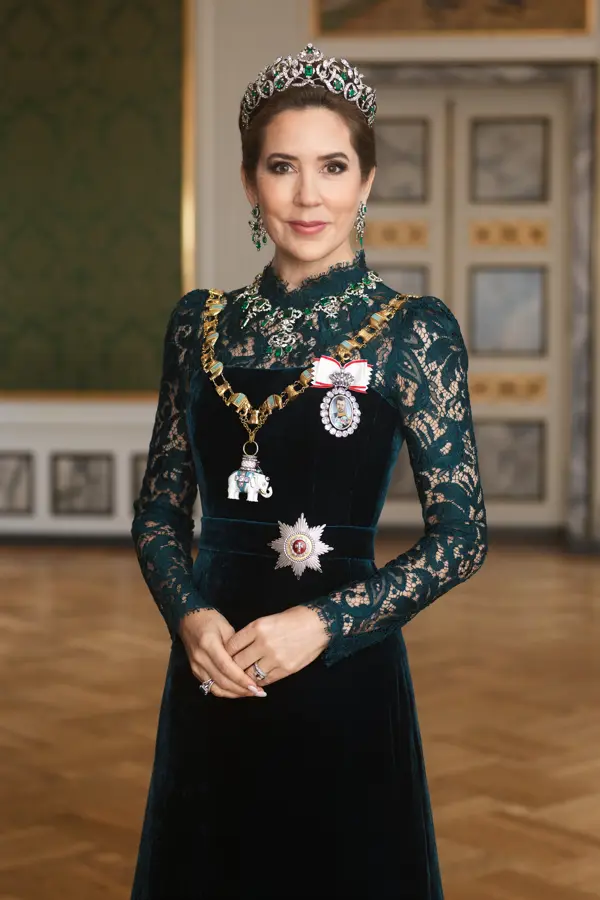Official gala portrait of TM The King and The Queen
In connection with the succession of the throne on 14 January 2024, the first official gala portrait of Their Majesties The King and The Queen is now published. The portrait shows Their Majesties in gala with the Order of the Elephant on chains, and the portrait can henceforth be seen hung in, among other places, state institutions, including at Danish embassies and consulates around the world and on Danish vessels.

The gala portrait was taken by photographer Steen Evald in the Green Room in The Royal Reception Rooms at Christiansborg Palace. The King and The Queen have thus had their portrait made at the historic palace in Copenhagen where successive kings and queens have stayed over time.
The King
The reigning monarch in Denmark at any time is the Sovereign of the Orders for the two royal orders of chivalry, the Order of the Elephant and the Order of Dannebrog. Therefore, in the portrait, The King wears for the first time a number of historical items which kings – and most recently Her Majesty Queen Margrethe – have worn during their reigns.
This applies first and foremost to the special elephant that His Majesty wears on a chain. The elephant was likely created in 1671 for the anointing of Christian V in Frederiksborg Castle Church, while the order’s chain was first made in 1693 in connection with the issuance of statutes (rules) for the Order of the Elephant. The distinctive mark of the elephant is five large, square, flat diamonds shaped as a cross, and the elephant is colloquially referred to as “The Mother Elephant”, as the object is the first elephant for the whole Order of the Elephant. According to tradition, this elephant is worn by the monarch for special occasions. Thus, Frederik IX and Margrethe II had a tradition of wearing the elephant each year on 1 January for the annual New Year’s banquet. At other events for which the Order of the Elephant is worn, the sovereign wears his or her own personal elephant.
In the portrait, The King also wears an Order of the Elephant breast star made for the anointing of Christian VI in 1731. In 1947, The King’s grandfather, Frederik IX, began to wear this breast star again on special occasions. At the bottom of the uniform, The King wears the breast star of the Order of Dannebrog, which was made for Frederik VI after the change in the order’s rules in 1808.
Both the elephant and the chain as well as the two breast stars The King wears in the gala portrait are ordinarily displayed together with the regalia – that is, the objects that make up The King’s badges of rank such as crown, sceptre, orb, coronation sword and anointing ampulla – in The Treasury at Rosenborg Castle.
The King wears the Navy’s full-dress uniform in the gala portrait. In connection with the succession of the throne, His Majesty was appointed to the rank of admiral, and the full-dress uniform is therefore fitted with four stars on the shoulder insignia. Around the neck, The King wears the Grand Commander Cross, which is the Order of Dannebrog’s highest rank.
The naval officer’s sabre which The King wears with the uniform belonged to Frederik IX and was given to His Majesty by Queen Ingrid in 1997 in connection with The King’s appointment to the rank of lieutenant-commander of the Navy reserve in 1997.

The Queen
The Queen wears the crown jewels for the first time in the portrait. It is the emerald set with tiara, necklace, earrings and a large brooch that can be divided in three parts. The emerald set is one of the four jewellery sets, or garnitures, which are at the disposal of The Queen of Denmark and are ordinarily on display in The Treasury at Rosenborg Castle.
The set was designed by the jeweller C.M. Weisshaupt and was a gift from Christian VIII to Queen Caroline Amalie, probably for their silver wedding anniversary on 22 May 1840. The set’s emeralds and diamonds are partly reused items from the jewellery collection of Christian VI’s Queen Sophie Magdalene, partly reused items from older bracelets, combined with newly purchased stones. The style consists of neoclassical forms – flower vines, bows and curled frames or cartouches, inspired by the French crown jewels of the time.
When the crown jewels are not in use, they are on display in The Treasury in the secured basement under Rosenborg Castle. It is customary that the crown jewels remain in Denmark, which means that they are not taken along on visits abroad. The Danish crown jewels are the only ones in the world that are both exhibited as museum objects and, at the same time, worn by the country’s queen.
On the breast, Her Majesty wears a brilliant diamond miniature portrait of The King in a bow of Order of Dannebrog ribbon. For generations, there has been a tradition that female members of The Royal Family wear a miniature portrait of the sovereign. Thus, in her time as Crown Princess, The Queen wore a portrait of Queen Margrethe.
In connection with the succession of the throne, The Queen has received a miniature portrait of The King. The portrait was created by the British artist Tom Mulliner and set in a gold frame with brilliant diamonds. The frame was once made for Empress Amelie of Brazil. As The Empress was childless, the frame was passed on to The Empress’s sister, Queen Josefina of Sweden. Later, the frame was passed on to Queen Josefina’s granddaughter, the later Queen Lovisa of Denmark, and she was thus the first Danish queen to wear a portrait of the Danish sovereign in this special frame. Later, Queen Alexandrine and Queen Ingrid wore the frame during the reigns of their husbands, and, from 1972 until the succession of the throne in January 2024, Queen Margrethe wore the frame with a portrait of her father, Frederik IX.



